Garden Bird Profiles - Healthy Life Essex
Home » Articles » Outdoor Life » Wildlife » Birds » Garden Bird Profiles

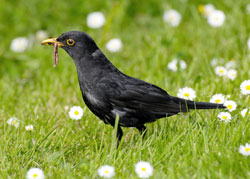
The males live up to their name but, confusingly, females are brown often with spots and streaks on their breasts. The bright orange-yellow beak and eye-ring make adult male blackbirds one of the most striking garden birds. The blackbird has a long tail and often hops along the ground with its tail up. It feeds on berries, scraps and apples, and searches for worms on the lawn. One of the commonest UK birds, its mellow song is also a favourite, often described as the finest song of all British thrushes. It is extremely varied and complex with almost no repetition. The bird adds to its repertoire throughout its life by inventiveness, learning and mimicry.
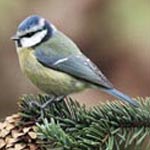
Its colourful mix of blue, yellow, white and green make the agile blue tit one of the most attractive resident garden birds. Almost any garden with a peanut feeder will attract it, it will also feed on seeds, and scraps from bird tables and the ground. In winter it forms flocks with great tits, long-tailed tits and other woodland species as they search for food. A garden with four or five at a bird table at any one time, may be feeding 20 or more birds.
The all-black carrion crow is one of the cleverest, most adaptable of our birds. It is often quite fearless, although it can be wary of man. They are fairly solitary, usually found alone or in pairs. The closely related hooded crow has recently been split as a separate species. The carrion crow will come to gardens for food and although often cautious initially, it soon learns when it is safe, and will return repeatedly to take advantage of whatever is on offer. Like other members of the crow family, it will regularly soak dry bread in water before eating.
The chaffinch is the UK’s second commonest breeding bird, and is arguably the most colourful of the
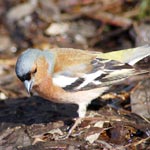
UK’s finches. Its patterned plumage helps it to blend in when feeding on the ground and it becomes most obvious when it flies, revealing a flash of white on the wings and white outer tail feathers. It does not feed openly on bird feeders – it prefers to hop about under the bird table or under the hedge. A chaffinch will usually be heard before seen, with its loud song.
Not as colourful as some of its relatives, the coal tit has a distinctive grey back, black cap, and white patch at the back of its neck. Its small bill, more slender than blue or great tits, means it can feed more successfully in conifers. It also feeds on the ground on seeds, scraps and insects, and will visit peanut feeders from where it will take and store food for eating later. In winter coal tits will join with other tits to form flocks which roam through woodlands and gardens in search of food.
Distinctive with its buffy-pink plumage, black neck collar and long, white tail with a black base, the collared dove is usually seen singly or in pairs, although flocks may form where food is plentiful. It feeds on the ground but readily perches on roofs and wires. It feeds on seeds and scraps, from and around the bird table. After rapidly spreading across Europe in the early half of the 20th century, the collared dove is now one of our most common birds and its monotonous cooing is a familiar sound.
A small, easily overlooked bird, the dunnock creeps around under bushes in a mouse-like way. It is a
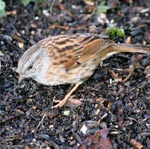
brown and grey bird with a slender beak, which it uses to catch its insect and spider food. The dunnock is sedentary, rarely moving more than one kilometre from its birthplace. When two rival males come together they become animated with lots of wing-flicking and loud calling. It also has an extremely promiscuous lifestyle.
Also known as town pigeons, feral pigeons are descended from rock doves, which were domesticated for food. Feral pigeons come in all shades, some bluer, others blacker – some are pale grey with darker chequered markings, others an unusual shade of dull brick-red or cinnamon-brown, and still others can be more or less white while others look exactly like wild rock doves. It feeds on scraps and seeds, both on the ground and on bird tables and may be very tame.

A small, dainty, highly coloured finch with a bright red face and yellow wing patch. Goldfinches often feed in small flocks, and its twittering call and black and yellow wings draw attention to it. It is a seed-eater that feeds on the ground, on seed heads of garden plants (although this is mainly male goldfinches as they have a slightly longer beak than females) and on seed-filled birdfeeders. It occasionally feeds from nut feeders, is partial to nyjer seed and will eat insects.
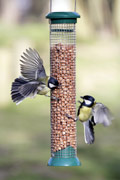
Great tit
Bigger than the blue tit, the great tit is green and yellow with a striking glossy black head, white cheeks and a distinctive two-syllable song. It is a woodland bird which has readily adapted to man-made habitats to become a familiar garden visitor. It feeds on seeds and scraps on the ground, on bird tables and from nut feeders. It can be quite aggressive at a birdtable, fighting off smaller tits.
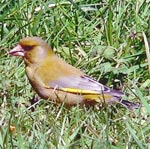
Its twittering and wheezing song, and flash of yellow and green as it flies, make his finch a truly colourful character. Nesting in a garden conifer, or feasting on black sunflower seeds on the ground, bird tables and feeders, it is a popular garden visitor. Although quite sociable, it may squabble among other greenfinches or with other birds at the bird table.
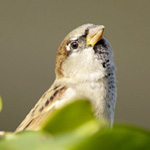
The noisy and gregarious house sparrow is one of our most familiar birds and is affectionately recognised as being a cheeky and loveable rogue with a promiscuous nature. It feeds on seeds, grains and scraps on the ground and on bird tables. The house sparrow also feeds from nut feeders and enjoys mealworms. It is sedentary and rarely moves more than two kilometres from its birthplace. The house sparrow is widely distributed throughout Britain. However, the population has declined by almost 60 percent in recent years earning it a place on the red list, along with other birds of high conservation concern.
Jackdaw
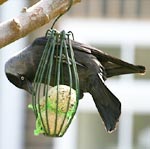
Smaller than a rook or a crow, the jackdaw is a blackish bird with a grey head, blackcap and white eyes. It has a distinctive ‘jack jack call’. It is sociable and usually seen in pairs or larger groups. It’s an acrobatic flier and flocks will often chase and tumble together in flight. On the ground it both walks and hops. The jackdaw feeds on insects, seeds and scraps.
The long-tailed tit is easily recognisable with its distinctive black, white and pink colouring, a tail that is bigger than its body, and undulating flight. Gregarious and noisy residents, long-tailed tits are most usually noticed in small, excitable flocks of about 20 birds. It feeds on insects, but is increasingly visiting garden bird tables and nut feeders in winter, when insects are hard to find.
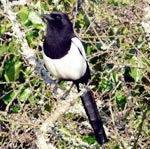
Magpies seem to be jacks of all trades – scavengers, predators and pest-destroyers, its challenging, almost arrogant attitude has won it few friends. With its noisy chattering, black-and-white plumage and long tail, there is nothing else quite like the magpie in the UK. When seen close-up its black plumage takes on an altogether more colourful hue with a purplish-blue iridescent sheen to the wing feathers, and a green gloss to the tail. It feeds on a variety of foods, including scraps. The word magpie is a shortened form of Margaret’s pie and other local names include madge, marget, miggy and maggot.
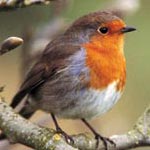
With its bright, orange-red breast, brown back and dumpy shape, the robin is a familiar garden bird and was officially adopted as Britain’s National Bird in 1960. The robin sings nearly all year round and despite its cute appearance, it is aggressively territorial and is quick to drive away intruders. The robin is the only garden bird to sing throughout the winter, with both males and females holding winter territories. It is unusual to see more than two birds at a time, except in very cold weather. It feeds on seeds, scraps, berries, insects and mealworms, both on the ground and on the bird table.
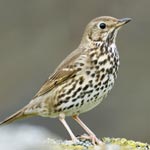
Such is its song’s popularity, that it recently topped an RSPB poll of the nation’s favourite songbirds. The song thrush has a brown head, back and tail, with pale under parts with dark brown, streaky spots. It feeds on worms, berries and scraps, and also on snails, which it smashes on stones. Although it is still a common garden bird, its numbers are declining at an alarming rate, and it is now red listed.
Starling
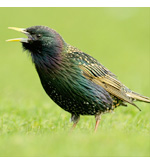
The starling is a familiar bird throughout Britain. It is famed for its ability to mimic the calls of other birds and the mechanical noises in its varied repertoire of song. Smaller than blackbirds, with a short tail, pointed head and triangular wings, a starling looks black at a distance but when seen closer it is very glossy with a sheen of purples and greens. Its flight is fast and direct and it walks and runs confidently on the ground. The starling feeds on scraps, seeds and from nut feeders; it also probes into lawns for worms and grubs. Although still common in gardens the past 28 years has seen its population decline by more than 75 percent making it another red listed species.
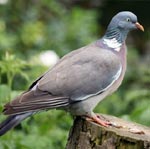
The UK’s largest and commonest pigeon, it is largely grey with a white neck patch and white wing patches, clearly visible in flight. Although shy in the countryside it can be tame and approachable in towns and cities. Its cooing call is a familiar sound in woodlands as is the loud clatter of its wings when it flies away. The woodpigeon feeds on grain, seeds, scraps, berries, buds and is quite partial to crops like cabbages, sprouts and peas.
Wren
A tiny, very active, dumpy bird, with a thin-beak and a raised tail. The wren is a reddish brown colour with some darker barring on the wings and belly. It has a very loud song for such a tiny bird: it uses this to help it hold a territory, sometimes even in winter. The wren feeds on insects and spiders.
 Bird populations reflect the health of the planet on which our future depends. The need for an effective bird conservation organisation has never been greater. Climate change, agricultural intensification, expansion of urban areas and transport infrastructure, and over-exploitation of our seas all pose major threats to birds.
Bird populations reflect the health of the planet on which our future depends. The need for an effective bird conservation organisation has never been greater. Climate change, agricultural intensification, expansion of urban areas and transport infrastructure, and over-exploitation of our seas all pose major threats to birds.
Photographs by:
Blackbird & Starling by Sue Trantor (RSPB)| Robin by Andy Hay (RSPB) | Female Blackbird by Chris Mills (RSPB) | Blue Tit (RSPB)
House Sparrow by Ray Kennedy (RSPB) | Great Tits by Nigel Blake (RSPB) | Song Thrush by David Tipling (RSPB)
Chaffinch by Turii Konoval | Dreamstime.com
Photographs of: Dunnock, Greenfinch,Goldfinch, Jackdaw, Magpie, Wood Pigeon courtesy of FreeDigitalPhotos.net
